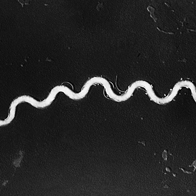The One-Two Punch of Diagnosing Syphilis

Known to doctors as "the great imitator," syphilis is one of a very select group of sexually transmitted diseases (STDs) that warrant a two-step testing process. The other is HIV, which is less because of chemical complexities and more because medical professionals want to be sure before handing out what has historically been a stigmatized diagnosis.
A variety of tests can be used to confirm a case of syphilis, first for screening and then a confirming diagnostic test, but the many options belong to one of two families.
"There are almost two dozen FDA-approved blood tests for syphilis, but they only fall into two categories: nonspecific tests and specific tests," said Ina Park, M.D., M.S., a professor at the University of California San Francisco School of Medicine.
Beware of false positives
Generally, both specific and nonspecific tests are serological, which means they require a blood sample for analysis. Neither category of tests, with one exception known as dark-field microscopy, is designed to detect the syphilis-causing bacteria known as Treponema pallidum. Rather, they measure the presence of antibodies produced as a response to the bacteria. The difference between specific and nonspecific tests is a question of which antibodies are being sought.
Another way to understand specific and nonspecific tests is to consider them treponemal and non-treponemal. Treponemal tests sense the specific antibody to Treponema palladium proteins. Conversely, non-treponemal tests gauge the presence of antibodies typically produced in reaction to syphilis, such as damaged host cells or lipoidal antigens, which are toxins present in fatty tissue.
"The [nonspecific] are primarily testing for antibodies against cholesterol, lecithin and cardiolipin, which are released when cells are damaged by a syphilis infection," Park explained. "Those antibodies are not specific to syphilis and can also be elevated with other infections, cancer or autoimmune diseases."
This is how false positives occur. Risk factors from malaria to intravenous drug use may produce identical antibodies. If a case of syphilis is new enough that antibodies haven't yet been produced, tests might instead result in a false negative.
"In the earliest stages of syphilis infection, a person may test negative for antibodies," Park explained. "The exact window period before someone tests positive will vary from person to person. To give some perspective, syphilis can incubate between 10 to 90 days before an ulcer appears, so there is a wide range of time before someone tests positive and before someone may show symptoms."
Nonspecific tests are typically less expensive than their specific counterparts, hence, the specific diagnostic tests are used only if screening has detected something unusual.
Specificity vs. sensitivity
"There's specificity and then there's sensitivity," said Adrienne Crowe, a certified nurse midwife in Denver and mother of the author. "Sensitivity is a test's ability to confirm the presence of a disease. Specificity is a test's ability to confirm the absence of that disease. A highly sensitive test means there's few false negatives but a chance of false positives."
However, it would be wrong to dismiss sensitive or non-treponemal tests as somehow inferior to specific and treponemal diagnostics.
For starters, a non-treponemal test such as the rapid plasma reagin (RPR) doubles as a means of tracking progress in a case of syphilis that's being treated. The RPR's counterpart, the venereal disease research laboratory (VDRL) test similarly provides assays of a specific case of syphilis, that is, the presence and amount of proteins. A treponemal test, meanwhile, won't provide such semiquantitative results.
"The treponemal-specific tests are positive for life once you are infected," Crowe said. "So you have to use the RPR/VDRL to see if someone has a new infection. And the RPR/VDRL are the only tests that can be used to monitor response to therapy because they give a numeric value [titer] that can be followed to ensure it goes down after treatment. There aren't other tests for STI/STD diagnosis that work in this way."
The antibody titer score is derived from the number of times a patient's serum can be diluted and antibodies still be detected. Scores of less than 1:160 are considered low, 1:320 is moderate and anything above 1:960 is high.
The life cycle of the Treponema bacteria is an important consideration in diagnosing or treating a case.
"Treponema, the bacteria that causes syphilis, is cyclical, but even during the dormant stage, testing will detect its presence," Crowe explained. "If left untreated, the damage is typically irreversible but can be stopped. For instance, in an advanced case, a person may have lost their sight due to syphilis, and while that sight can't be regained, further damage can be prevented."
Single-step testing
We've established that screening tests (sensitive, nonspecific non-treponemal tests) detect while diagnostics (specific treponemal tests) confirm. However, there's one anomaly: a single-step means of testing for syphilis that demands exact circumstances.
Park invites us into this process in her book, "Strange Bedfellows: Adventures in the Science, History and Surprising Secrets of STDs."
"This is where a darkfield microscope comes in," she writes. "It condenses the light into a beam, then scatters it obliquely through a drop of oil placed against the bottom of the slide. Performed in the dark, the scant light produces an image like an X-ray: bright white against a black background. Darkfield microscopy is a dying art. As of 2019, the microscope at City Clinic was one of nine in the entire state of California. As far back as 2009, a study of US infectious disease specialists found that only 1 in 10 had ever used darkfield microscopy to diagnose syphilis.
"All the stars must align to perform a darkfield successfully," Park noted about the rarity. "The patient must show up with an ulcer moist to produce enough fluid for the test. The fluid must be examined immediately to visualize the bacteria while they are still alive. But when conditions are right, the tiny white corkscrews of Treponema pallidum twist and undulate against a starry black background."
Dark-field microscopy, an obscure and delicate means of testing using a specialized microscope, detects the actual source of syphilis—the Treponema bacteria—and not the consequences of the bacteria's presence. The one-step method removes the potential distress inherent in screenings and subsequent diagnostics, but between its highly specific circumstances and unique technology, dark-field microscopy simply isn't a viable option for mass testing.
"The great imitator" has inspired the innovation of numerous methods of testing with unique strengths and shortcomings. What's most important for any responsible individual is to know an abnormal result in screening isn't the same as a diagnostic confirmation. The best means of action is to await your medical professional's advice and take measures to support your immune system.




















